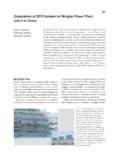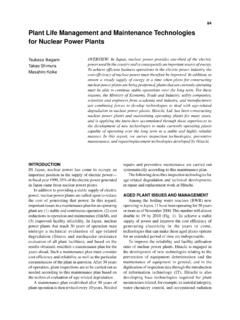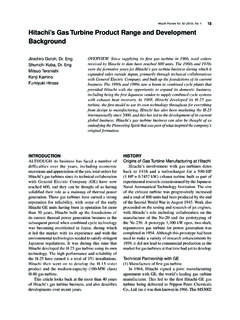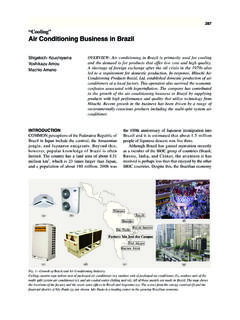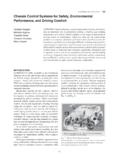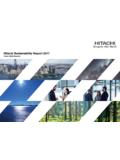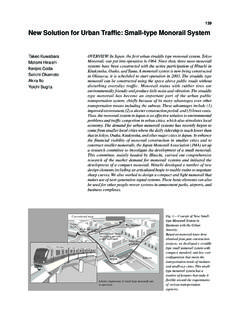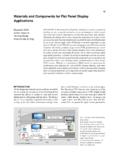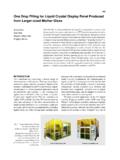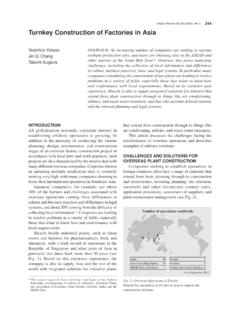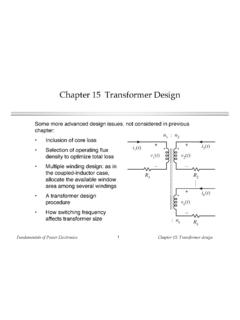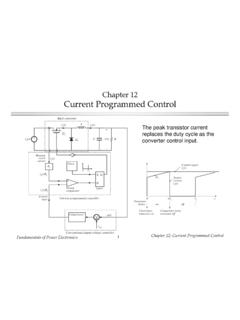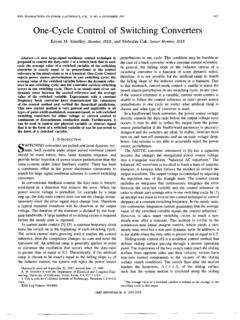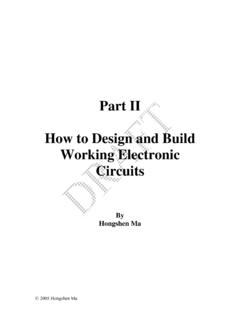Transcription of Power Electronics Technologies for Railway Traction Systems
1 Hitachi Review Vol. 61 (2012), No. 7 306. Power Electronics Technologies for Railway Traction Systems Yasuhiko Kono OVERVIEW: To satisfy a growing global market, Hitachi supplies a wide Ken Ito range of Railway Traction system products to meet diverse customer needs Hiroshi Okawara that extend from commuter to high-speed trains. This has included the development and commercialization of a standard medium-capacity inverter Toru Fukuma with a mass and external dimensions that are less than those of previous models by 20% or more. For high-speed rolling stock, Hitachi has developed an inverter that has roughly double the output of Japanese models, and that is designed for use with rolling stock, motors, and other components that comply with European specifications. This inverter is currently undergoing field trials.
2 To improve rolling stock energy efficiency further and reduce maintenance requirements, Hitachi has also developed a Traction system with 35% lower inverter losses, including the development of a highly efficient enclosed induction motor (efficiency improved from 91% to 95%) and SiC. hybrid modules that combine SiC diodes with Si IGBTs. INTRODUCTION models, used in applications such as monorails, up to THE international trend toward energy efficiency is units for use in the Shinkansen and other high-speed making railways increasingly important, and there is a trains. The following sections describe the different need for the timely supply of a diverse range of Traction types of Systems . Systems that are not only highly efficient and reliable, but also satisfy the market requirements of each country.
3 MEDIUM-CAPACITY Systems . In addition to offering a wide product range that Hitachi offers four different medium-capacity meets these needs, Hitachi has also responded to the Traction Systems to suit different applications. The growing demand for energy savings by developing following sections describe their technical features new Traction Technologies , including a highly efficient and examples of their use. enclosed induction motor and silicon carbide (SiC). hybrid inverter. Standard Systems This article describes the features of Hitachi's Hitachi supplies a range of standard inverters(1) that range of electrical components for the Traction circuits are smaller, lighter, and easier to maintain than previous used in Traction Systems for both conventional and models thanks to use of components such as low-loss/.
4 High-speed trains, and also newly developed next- low-noise insulated-gate bipolar transistors (IGBTs). generation Traction circuit technology. and highly efficient cooling Systems , the adoption of unit-based designs that make effective use of built-in HITACHI'S Traction Systems FOR components, and the elimination of components such ROLLING STOCK as fans that have a limited operating life (see Table 1). Table 1 lists Hitachi's range of Traction Systems for (1) Series 209 experimental train of East Japan rolling stock. The range extends from small-capacity Railway Company (MUE-Train). TABLE 1. Hitachi's Range of Traction Systems for Rolling Stock The six different types differ based on parameters such as control capacity and functions. Medium-capacity Systems Small-capacity For low-floor rolling AC system / AC-DC High-capacity Systems Systems Standard With brake chopper stock dual system Subways, monorails, Urban transportation High-speed rolling Urban transportation Linear subways Intercity transportation etc.
5 (without regeneration) stock AC: alternating current DC: direct current Power Electronics Technologies for Railway Traction Systems 307. MUE-Train: multi-purpose experimental train Fig. 1 Series 209 Experimental Train (MUE-Train). The MUE-Train commenced field trials in October 2010 using a standard inverter adopted for use in the next-generation rolling stock control system. The East Japan Railway Company is developing height of the inverter. Accordingly, Hitachi's range a next-generation rolling stock control system for of standard models has been extended by revising the experimental Series 209 [the multi-purpose the location of components, modifying the cooling experimental train (MUE-Train)]. The inverter for system design, and optimizing the placement of parts this system is a standard inverter for which the East inside the inverter unit to suit low-floor rolling stock, Japan Railway Company was the first user.
6 The control resulting in an inverter unit with a height of only system uses Ethernet to transmit control signals (see 500 mm (24% less than standard model). Fig. 1). (2) Additional units of the East Japan Railway AC and AC-DC Dual Systems Company's Series E233-3000 By applying Technologies from standard models to A standard inverter adopted for additional units alternating current (AC) and AC-direct current (DC). of the Series E233-3000 featured smaller size and dual Systems , these have been made smaller, lighter, lighter weight than the inverter used in the earlier units (see Table 2 and Fig. 2). Despite this, the old TABLE 2. Comparison of Inverters Used on Series E233-3000. and new inverters are mutually compatible in terms The table below compares the dimensions and weight of the old of installation and performance.
7 And new inverters used on the Series E233-3000. Parameter Initial rolling stock Additional rolling stock Systems with Integrated Brake Chopper External dimensions 3,390 740 725 2,950 740 650 (-22%). For urban services outside Japan, where it is often (W D H) (mm). Weight (kg) 1,030 790 (-24%). difficult to achieve an adequate regenerative load, Hitachi has commercialized an inverter for use with brake-generators that incorporates the brake chopper in the same housing. Integrating the brake chopper has reduced the weight by 14% compared to previous equipment. Systems for Low-floor Rolling Stock Fig. 2 Inverters Used on Additional Series E233-3000 Units. The restricted amount of space available for The inverters used for additional Series E233-3000 units installing equipment below the floor of subway cars were standard models.
8 They were smaller and lighter than the equipped with linear motors places a limit on the inverters used on earlier units. Hitachi Review Vol. 61 (2012), No. 7 308. and easier to maintain than previous models. These in the 600-kW range. The following sections describe Systems include both converters that convert single- examples of these two different types of system. phase AC to DC and converter-inverter Systems that incorporate an inverter. Small, Lightweight Systems for Use in Japan A feature of Hitachi's converter-inverter Systems Since the adoption of IGBTs in 1997 on the Central is that they use T-shaped three-level converters to Japan Railway Company's Series 700 Shinkansen minimize Power supply harmonics and noise. To make rolling stock, the predominant configuration for them smaller and more efficient, the T-shaped three- converter-inverter Systems for the Shinkansen has level converters have a simple design that also uses consisted of three-level converter-inverters with proprietary Hitachi circuit techniques to eliminate the kV IGBTs.
9 Clamping diodes used on previous three-level Traction The East Japan Railway Company's Series E5. circuits(2). Shinkansen rolling stock, which entered commercial The converter-inverter system on the East Japan operation in March 2011, is intended to be connected Railway Company's Series E657 express trains for with the new Series E6 Shinkansen rolling stock the Joban Line that entered commercial operation (scheduled to commence commercial operation in the in March 2012 combines the T-shaped three-level spring of 2013) that will operate through-train services converter with a DC rolling stock inverter Power unit on an existing line. There are plans to operate the from the same series as that described above. Series E5 and E6 Shinkansen connected, with speeds The converter Power units for the Kyushu to increase progressively up to Japan's maximum Railway Company's 817-2000 and 817-3000 Series speed of 320 km/h after services commence.
10 Use this three-level Traction circuit and incorporate Hitachi has prepared a common design for the low-noise, snubber-less Traction circuit technology converter-inverter Systems used in both the Series that is implemented in the inverter. Thanks to the E5 and E6 Shinkansen rolling stock, and has made small size and UV phase integration, the converter- the operation and maintenance of Traction circuit inverter system consists of two independent sub- equipment more efficient. Because the Series E6. Systems to provide redundancy even on short trainset Shinkansen rolling stock will also run on conventional configurations. lines, they require a small converter-inverter system to suit their small carbody. Traction CIRCUIT FOR HIGH-SPEED The Power unit of the converter-inverter system for ROLLING STOCK the Series E5 has an integrated configuration consisting While trains speeds are increasing to more than of two converter phases and three inverter phases.
